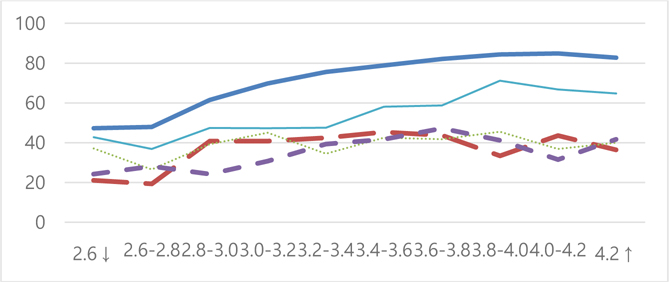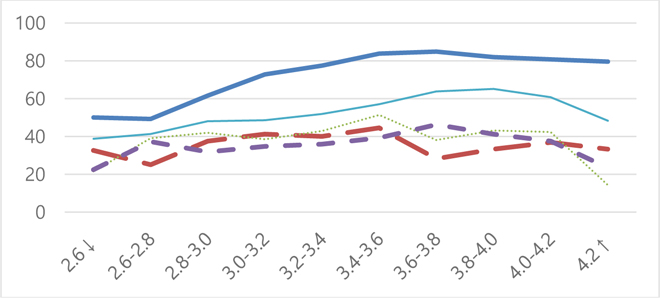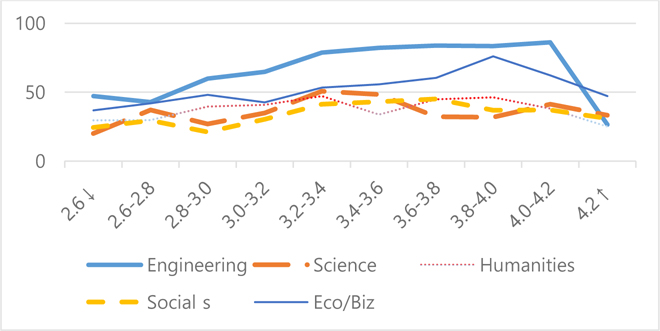



This study is a response to the Korean situation where the unemployment rate among the young generation is 9.3% as of May 2015, reaching 54.5% for humanities graduates in 2014 (Joint Ministries, 2015). This situation underlines several theoretical issues such as the determinants of employment, role of universities and criteria for unemployment. The determinants of employment for undergraduate students are closely linked to the role of universities, since tertiary education institutes provide knowledge for jobs. Hereafter we will call tertiary education institute as simply university.
Many studies consider the determinants of undergraduate employment as personal attributes or motivation (for example, Deci et al., 1991; Harackiewicz et al., 2002). However, we think that learning knowledge from universities is essential for tertiary education students. This study seeks to find out the role of universities on the employment of undergraduates.
If we concentrate on the role of universities, we easily find that most current studies focus on a new role of universities in entrepreneurship, adding to their traditional role of education and research (OECD and European Commission, 2012; Seol, 2012). This study, however, deals with the oldest mission of university, namely, education and training and its purpose.
We compare the role of university by disciplines, since it is different by colleges or disciplines. This study is an extension of Park’s study (2015a, b), which analyzes the role of universities in science and engineering as regards undergraduate employment.
When it comes to getting students ready for employment, most universities provide employability-related support programs. Therefore, there are many studies on the effects of these programs, which is discussed in the literature review section. However, another important service toward employment universities offer is often overlooked - regular curriculum. In addition, personal attributes and students employment-related activities are also important. The data are extracted under five categories such as personal attributes, entrance attributes, student efforts, regular curriculum and employability-related support programs. The latter two categories provided by universities, especially by disciplines, are the main focus of this article.
We consider Korean data from a university over four and half years (University A, 2015), producing a sample of 7,616 who had all the data for 28 factors. While we will review some Korean studies reflecting the data, we discuss and refer to international studies as well. For example, there are some studies on the general difference between subject disciplines, but there are few studies on the difference of employment between subject disciplines. Lee and Yeon (2012) showed the difference of employment by disciplines. Cho, Kim and Kim (2008) showed the overall difference of employment and Kim (2009) showed job preparation activities across disciplines. Lim and Lee (2008) discussed the preparation process and employment.
We suggest an analytical framework in section 2 with the discussion of existing studies. Section 3 provides the detailed methodology and the data, and section 4 shows the result of the analysis. The final section 5 discusses the theoretical and policy implications.
The study looks at the role of universities on undergraduate employment by disciplines. The literature related to these issues is quite diversified – role of universities, determinants of undergraduate employment, employability-related support programs provided by universities, relationship between regular curriculum and employability-related support programs, reasons of undergraduate unemployment, and policy for undergraduate employment, etc.
However, we bring into focus the theoretical review of several issues from our previous studies: Seol (2012) for the role of universities and Park (2015a, b) for determinants of undergraduate employment. Here, we add a review of the latest studies and summarize our previous work. Studies on unemployment of undergraduates will not be reviewed here, but will be mentioned in the last discussion section.
There are many studies on employability according to the definition of the UK Higher Education Academy (Pegg et al., 2012). “A set of achievements, skills, understandings and personal attributes that make graduates more likely to gain employment …” In this definition, four factors are mentioned for employability: achievements, skills, understandings and personal attributes.
O’Leary (2016) collected the views of 104 graduates across subject disciplines for employability-related support in undergraduate degree programs. Although his results are different by disciplines, gender, experience and attitudes, 90% think the programs are important for gaining employment. As to the difference by disciplines, the paper finds that more than 80% of graduates from engineering and social science want such a program in “a well-managed way”. The distribution of responses between both disciplines is nearly the same. On the other hand, if some 50% graduates from science and humanities want these programs to be in “a well-managed way”, about 40% want them to be in “limited optional way”. Also, the distribution of responses across these two disciplines is nearly the same. O’Leary’s discussion was that employability-related support programs are critical in connection with curriculum. But the balance between curriculum and these programs is important.
Finch et al. (2013) identified 17 factors for employment from a survey of 115 employers. His results point especially to the importance of soft skills and problem-solving techniques as does the study by Andrews and Higson (2008) and a Korean study by Baek (2013). However, Cranmer (2006) says that soft skills cannot be achieved in classrooms. That means another effort for employment ought to be needed.
Park (2015) only deals with employment, not employability, to find out the determinants of employment using the vast range of actual data. He defines employment according to three types: employment only, preferred jobs and the best of the top 500 companies, through an extensive survey of the existing literature. In addition, Park organizes the 17 factors of employment under four categories: personal attributes, curriculum activities, extra-curriculum activities and job preparation activities of students. His purpose is to find out the role of universities on employment in engineering. Therefore, curriculum and extra-curriculum programs provided by universities are important for the analysis.
Park (2015) summarizes the determinants. The factors in the category of personal attributes are gender, age and family income. The results related to gender are: 1) pros for male students, 2) pros for female students, and 3) better quality of male students over female students. The studies related to family income are summarized as follows: 1) pros for high income, 2) no correlation, and 3) cons for high income. Age is generally a negative factor for undergraduate graduates. In addition, transferred students from other universities are disadvantaged in getting jobs.
The studies on employability-related support programs focus on internship, courses for employment, and career setting programs. Studies showing the impact of internship and career setting programs on employment are pros and cons, but most studies show a positive impact of courses for employment and specific employability programs. O’Leary (2015) highlights another factor, entrepreneurship in higher education. The employment impact of grade point average (GPA) as the result of regular curriculum on employment is split between pros and cons.
We define employability support programs, or simply employability programs, as all efforts deployed by universities toward employability. That includes curriculum for jobs, curriculum for career setting courses and all extra-curriculum programs for jobs, etc. Curriculums for jobs and career setting courses are special subjects that require grade points, except the original subjects of each department. The extra-curriculum programs for jobs are called simply as employment programs. In addition, we separate exchange programs, internships and graduation delays from other university-related determinants, since they are easily identified.
This study goes further to include several perspectives from existing studies. First, accumulated student activities, which add to general personal attributes, are also important for securing jobs. These activities may be proxies for achievement goals, efforts and student motivation, mentioned in Harackiewicz et al. (2002) or Deci et al. (1991). Second, if universities provide employability programs, what kinds of programs are decisive for employment, adding to the traditional curriculum activities? Third, what are the detailed programs for extra-curriculum programs, and employment programs?
In Table 1, we define an analytical framework containing 28 factors with five categories: 1) personal attributes, 2) entrance attributes, 3) student activities, 4) regular curriculum, and 5) employability programs of universities. With so many factors, we omit the detailed definition of each of them. Some of these factors are described in Park (2015). We classify them in Table 1 with little explanation. Personal attributes include gender (male or female), age (number), hometown (Capital area or not), and family income scholarship (yes or no). Another personal attributes such as entrance attributes are classified into national test score (grade), screening (yes or no), high school score (number), and transfer from other universities (yes or no).
[Table 1] Framework for factors on employment
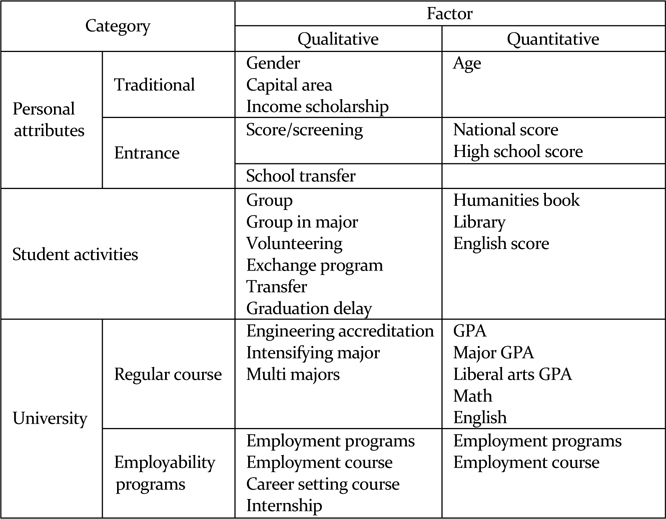
Framework for factors on employment
Student activities include general group activities (yes or no), activities in own major on department (yes or no), volunteering (yes or no), participation in exchange program (yes or no), number of humanities books from library, number of library entrance, and English score (number).
Regular courses in university determinants are education under engineering education accreditation program (yes or no), education under intensifying major program (yes or no), multi majors (yes or no), transfer within universities (yes or no), and graduation delay (yes or no).
Employability programs are shown in Table 2, except employment courses (yes or no), career setting courses (yes or no), and internship (yes or no). The factors shown in Table 2 will be checked by yes or no, or the number of participation.

Employment programs
The purpose of this study is to find out the role of universities on employment by subject disciplines. If we examine this process from a policy point of view, our study is an answer to these questions:
1. What factors have a big impact on employment: student or university?
2. From the university point of view, which program is more effective: regular courses or employability support programs?
3. If students’ role is not neglected, which sub-factor has a big impact on employment: personal attributes or student activities?
4. Further, what is the difference in the role of universities among disciplines?
In detailed aspects, this study differs from existing studies. First, it is difficult to find studies about engineering education accreditation program, intensifying major program and transfer students. Second, although there are some studies using the individual database of certain universities in Korea (Chung and Lee, 2005; Cho, Kim and Kim, 2008; Cho, 2011; Choi, 2013), there is no study that uses the data spanning several years and covering the data of 28 factors. Third, there are few studies that seek to explore the relationship between employment and general group activities, group activities in major, and volunteering of student activities.
1.1 Definition of Subject Disciplines and Employment
The initial step of this study is to define the concept of subject disciplines and employment. We follow the classification of subject disciplines set by the Ministry of Education of Korea for statistics on employment. Subject disciplines are classified into humanities, social science, business and economics, science, and engineering.
Employment can be defined in several ways reflecting the quality of jobs. However, we follow Park (2015): 1) total employment, 2) preferred jobs, and 3) top 500 companies. We use the employment statistics of the Ministry of Education. The shortcoming of this statistics is the difficulty in identifying regular and temporary jobs.
1.2 Grouping and Test for Group Difference
This study defines several groups. Therefore, the test for group difference is essential, and we checked through the x.2 test.
1.3 Analysis
The analytical models using regression analysis are applied to the three definitions of employment. Employment data in all the definitions are 1 (employment) or 0 (non-employment), so we adopt the Binomial Logistic Regression Model. The analysis includes three steps. In the first step, a regression analysis was carried factor by factor for 28 factors. If there is no statistical significance in one of the three definitions, the factor was deleted. In the second step, we applied regression analysis for all statistically meaningful factors through the hierarchical process to find out a better model. Therefore, the total number of regression analysis was 93 (28*3+3*3). In addition, the third model is for 10 factors of employability programs. Because of space limitation, except if results are decisive; we omit the detailed regression results of each test or analysis.
The data is from August 2009 to February 2014; there were changes in the definition of employment before and after this period. The sample size of the data is 7,616 as shown in Table 3. The employment ratio of total employment under the three definitions are 36.7-74.5% by subject disciplines, those of preferred jobs scored 15.4-54.4%, and top 500 companies 3.2-40.8%. Among personal attributes, female students range from 16.4% to 61.3% in each school, and students from the Capital area from 61.7% to 76.2%. Students receiving scholarship income account for about 16% in all schools. The criteria for college entrance are national test score and university’s own screening, and further transfer from other universities. Students from screening represent 44.0-54.9%, and transferred students represent 9.3-14.6% of schools.
[Table 3] Statistical distribution
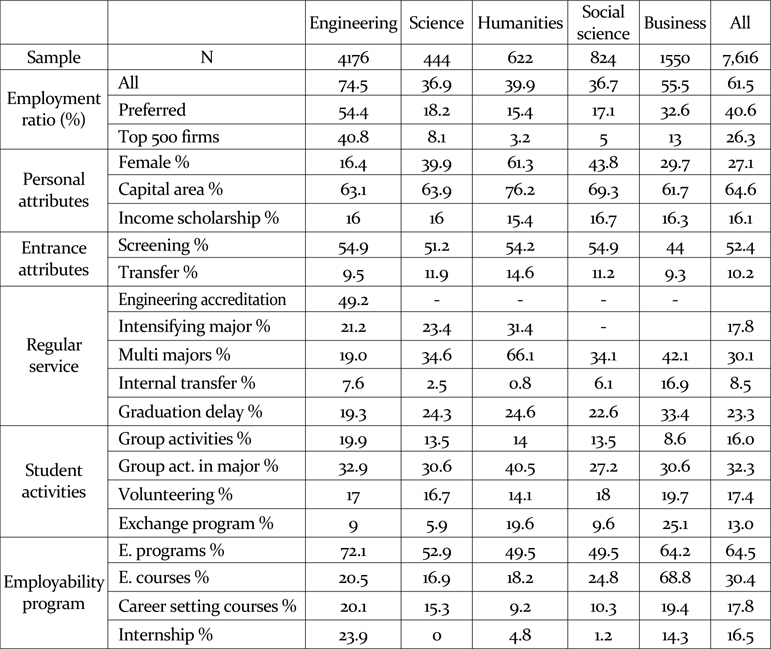
Statistical distribution
As for the regular service, engineering has a special program of the engineering education accreditation. If a department does not register with the engineering education accreditation program, it can sign up for the intensifying major program. About half the students are in the engineering education accreditation program, and from 10% to 31% in each area are in the intensifying major program. Students who select multi majors are 18.5-66% by disciplines. The multi major students in humanities are 66%, followed by business with 42%. Engineering is the lowest with 19.0%.
Also there are big differences in student activities. The students who engage in group activities in major or department are 32.1% and those involved in general group activities are 16%. Group activities are in the range of 8.6-19.9% by disciplines, but group activities in major are quite different, ranging from 27.2% to 40.5%. Students who signed up to an exchange program are 6-25%, and this program is similar to a program for humanities and business.
As for the employment preparation activities of student, it is noticeable that 72% of engineering students participate in the employment programs. Students who took the employment courses are 68.8% in business and 17% in science. As for the career setting course, engineering scores the highest with 20.1%; for internship, engineering ranks first with 23.9%.
The resulting data and summarized as follows:
• Total employment rate is 61.5%, which of preferred jobs is 40.6%, and top 500 companies 26.3%.
• As to the three definitions of employment, male students score 66.4%, 45.6% and 30.9%, respectively, and female students, 48.5%, 27.2% and 13.9%.
• As to subject disciplines, engineering ranks first with 74.5% followed by business with 55.5%, science 36.9%, humanities 39.9%, and social science 36.7%.
• 30.1% of students take multi majors.
• 32.3% of students participate in group activities in their own major, but 16% for general group activities.
• 13% students participate in exchange programs.
• About 65% students join in the employment programs provided by the university, and 30.4% of students take part in employment courses. Furthermore, 17.8% of students take the career setting course and 16.5% the internship program.
1. Impact on Employment of Each Factor
We tested the impact of each factor on employment. Table 4 shows the results of the qualitative factors and Table 5 the result of the quantitative factors. Looking at the difference by subject disciplines, nearly all the factors impact in engineering, but only the intensifying major factor affects employment in science. Even personal attributes, regular service, and students’ efforts have no impact on employment. The same is observed in humanities and social science. On the other hand, some student efforts and employability by university have an impact on employment in business.
[Table 4] Employment effect of each qualitative factors
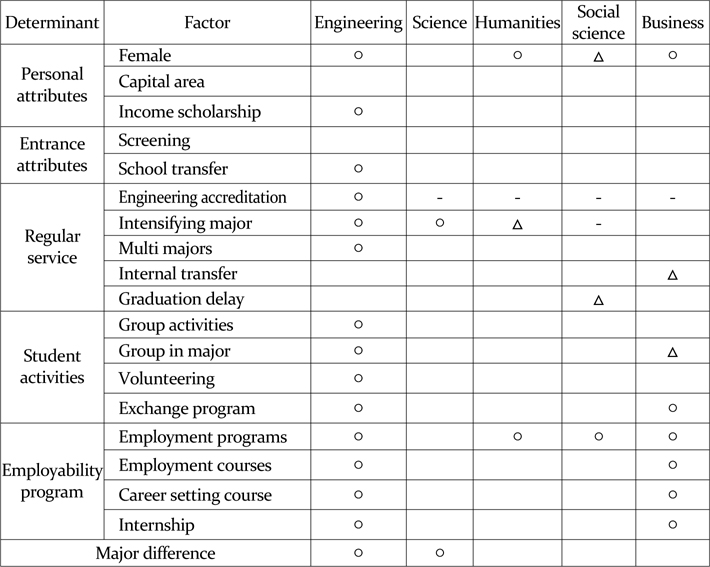
Employment effect of each qualitative factors
[Table 5] Employment effect of each quantitative factors
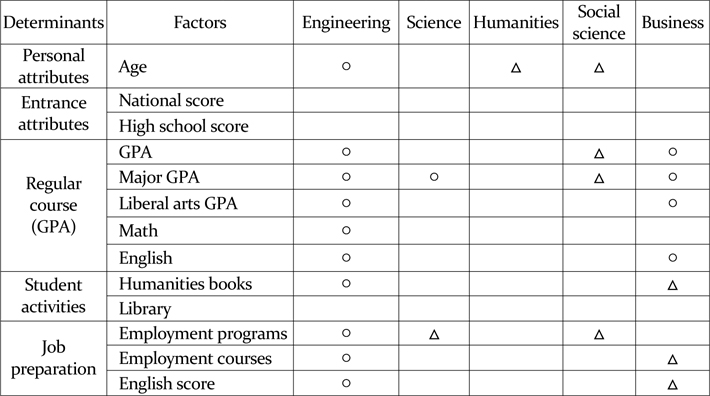
Employment effect of each quantitative factors
As for quantitative factors, a similar trend is observed with respect to subject disciplines. In engineering, nearly all the factors except entrance attributes have an impact on employment, but no factors except major GPA has an impact on employment in science and social science. To make matters worse, only age has an impact on employment in humanities.
We investigate the impact of GPA on employment in detail. The results are similar to those of other factors. As for major GPA, there is a group difference only in engineering and business. Figure 1 shows why. In engineering and business, if the GPA increases to 3.8-4.0 or 4.0-4.2, then the employment rate of two subject disciplines also increases, and employment rates decrease after the interval. Employment rates of other subject disciplines, however, have little prospect after the interval of 2.8-3.0. Figure 2 shows the impact of liberal arts GPA, and Figure 3 for total GPA, but the trend are similar to that of major GPA.
2. Logistic Regression Analysis
The result of the final model with 17 factors is shown in Table 6. Twelve factors among 17 have statistical significance in engineering, but only exchange programs and employability programs have an impact on employment in science. Few factors have an impact on humanities and social science. Exchange programs, internships, employment programs and employment courses have an impact on employment in business. Gender, especially female, is negative correlated in employment.
[Table 6] Results of aggregated model
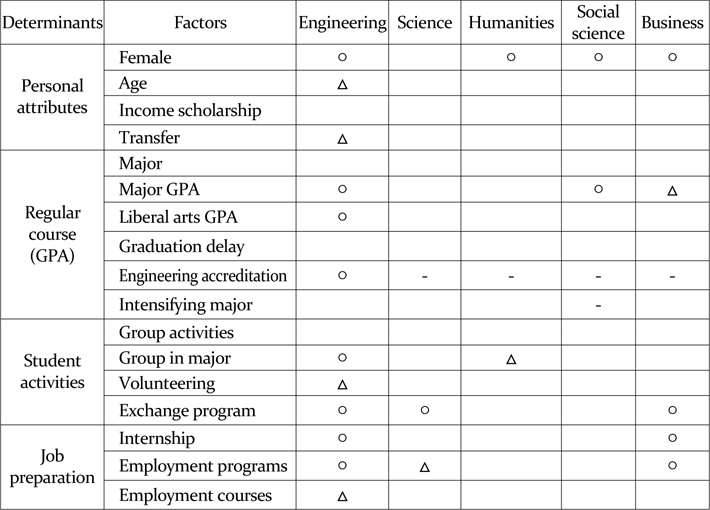
Results of aggregated model
We look into the effects of employment programs in detail as shown in Table 7. Nearly all the small programs have an impact on employment in engineering, but no impact in science. In addition, there is no impact of employment programs in humanities, social science and business except face-to-face coaching.
[Table 7] Employment effects of employment programs
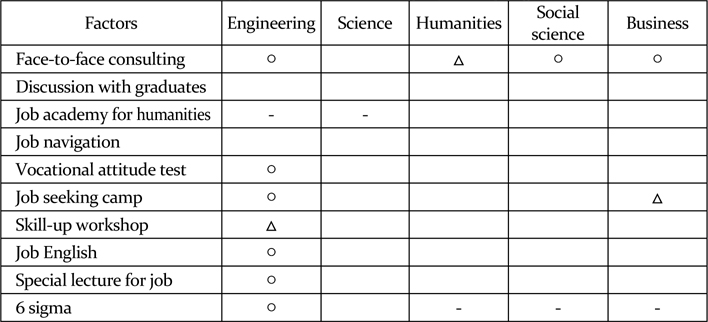
Employment effects of employment programs
Let’s examine the effects of all the factors at the same time. First, in all disciplines except engineering, regular curriculum and courses have no impact on employment. Only major GPA his meaningful in business and social science, but even this factor does not have an impact on humanities and science. Then, what is the role of universities on employment in most subject disciplines?
Second, this result gives us an educated guess that regular curriculum is important in engineering, and the quality of education like engineering education accreditation and the reputation of the department. But, there is no impact of intensifying major program in engineering.
Third, the factors with the biggest impact in engineering are different by definition of employment as shown in Table 8. For the top 500 companies, department reputation measured by the proxy factor of ‘over national average’, participation in the employment programs, major GPA are the key factors. For preferred jobs, only the order has changed: major GPA, department reputation, participation in employment programs. However, for total employment, the important factors are department reputation, internship, exchange programs, participation in employment programs and major GPA. In summary, the most important factors for engineering are department reputation, major GPA and participation in employment programs.
[Table 8] Key factors for engineering

Key factors for engineering
Fourth, employment programs are also important for engineering. Table 9 presents the detailed impact of employment programs. Although there is a difference of degree, job-seeking camp is good for all the definitions of employment.
[Table 9] Good employability programs in engineering

Good employability programs in engineering
Fifth, Table 10 shows the analytical results for non-science and engineering (S&E). It is noticeable that female, age and group activities of students have negative impacts on employment for non-S&E. Exchange programs, internship and employment programs are the key factors for these students.
[Table 10] Good employment factors in non-science and engineering

Good employment factors in non-science and engineering
Sixth, face-to-face coaching and job seeking camp among employment programs have good impacts in non-S&E.
[Table 11] Employment programs for non-science and engineering

Employment programs for non-science and engineering
This study starts from the perspective that preparing students for employment is the most important role of undergraduate degree programs. Therefore, we examine the determinants of undergraduate employment, especially highlighting the differences by disciplines. We classify 28 factors into five categories such as personal attributes, entrance attributes, students’ employment-related activities, regular curriculum and employability programs provided by tertiary educations imstitutes.
The unique nature of this study is that it is based on data from a Korean university spanning four and a half years. Although there are papers highlighting college factors by Moon and Noh (2013) and Kim and Seo (2013), employment program by Noh, Park and Hur (2011) and Lee (2007) or students’ activities by Nam, Yoon and Lee (2010), these studies are based on small data samples examined from restricted perspectives.
Total number of graduates are 7,616 and the description is as follows:
• Total employment rate is 61.5%, which for preferred jobs 40.6%, and for top 500 companies 26.3%.
• The employment rates of male students are 66.4%, 45.6% and 30.9%, respectively, in each definition of employment. Those of female students are 48.5%, 27.2% and 13.9%, respectively.
• The employment rate of graduates in engineering tops 74.5%, in science 36.9%, in humanities 39.9%, in social science 36.7%, and in business 55.5%.
The final analysis was carried out with 17 factors that have statistical significance. The impacts of these factors on employment in each discipline are summarized as follows:
• Twelve factors among 17 have statistical significance in engineering. Only exchange programs and employment programs have an impact in science. There are no specific factors that impact employment in humanities and social science. GPA and students’ efforts are important in business. Therefore, regular service and university efforts have no impact on employment except engineering and partially business.
• In engineering, department reputation and special programs for leveling up regular courses like engineering education accreditation is crucial to employment. In addition, student effort for the course (GPA) is important. However, other efforts to enhance the quality of major or department like intensifying major program do not have an impact on employment.
• In non-science and engineering, students’ effort for jobs is important such as exchange programs, internships and employment programs.
• Among employment programs, face-to-face coaching and job seeking camp are meaningful for employment.
The interpretation of the results of this study may point to the fact that universities have no role in helping graduates in science, humanities and social science find employment, if employment is the first mission of an undergraduate degree as shown in O’Leary (2016). We would not say that there is no role for the university even in these disciplines. Rather, the issue is that of over-education that exceeds job requirements, resulting from the worldwide expansion of higher education service: Taiwan by Wu (2011), Germany by Plümper and Schneider (2007), Japan by Walker (2007), China by Li et al. (2009) and Bai (2006), Korea by Kim and Lee (2006), Spain by Dolado et al. (2000) and UK by Mayhew, Deer and Dua (2004).
From a policy point of view, this study may be a call for a university restructuring in the disciplines. From a university point of view, we have to find employability-related support programs for the graduates of science, humanities and social science. These observations lead us to a new research agenda:
• Regular curriculum is important on employment only in engineering and business. Then what curriculum is needed for the undergraduates of humanities, social science and science for employment?
• The reputation of a department is important for engineering graduates. This fact supports the effort of every good engineering school.
• Employability programs provided by universities and colleges are important for graduates in all disciplines. And this fact is also supported by Korean studies such as Kim (1995), Shin (1997) and Lee (2007). Therefore, this program should be strengthen in all universities and colleges.
• Female employment should be encouraged.
This study reflects the Korean situation in mid 2010 with the school enrollment rate of 80%, characterized by the over-supply of college students in view of the job market, especially in humanities, social science, and even science. Nonetheless, the self-restructuring of disciplines by each university is difficult as pointed out in Bardhian, Hicks and Jaffe (2013). The Korean government has initiated a policy of reduction in the number of students in humanities and social science since the second half of 2014. The policy already produces an average of 10% reduction of university enrollment quota, which was approved by the Ministry of Education in the 2015 restructuring. In 2017, the Ministry’s second evaluation of university restructuring effort is planned to reduce enrollment quota by a further average of 14%.
This study is based on a university located in the Capital area of Korea having a strong base in science and engineering. Therefore, other universities with weak bases in science and engineering or other overseas universities with different enrollment rate may have different results. We hope additional studies in Korea and other countries to figure out the difference between subject disciplines and further the role of universities.





